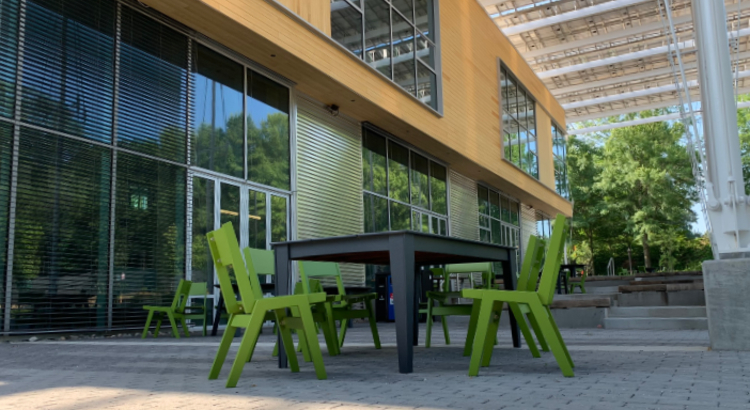In countless ways, the coronavirus pandemic is changing how buildings are used. New design trends are surely following, and many of those changes will bolster longstanding efforts to enhance sustainability.
One of the big shifts that’s likely to stick around: Owners and tenants are expressing more interest in breaking down the barriers between indoor and the outdoors.
Even before 2020, incorporating operable windows and programmable outside spaces adjacent to buildings had become an emphasis of regenerative design. Not only can non-conditioned space cut energy demand; there’s also increasing evidence that putting people in closer contact with nature helps to enhance their productivity.
It’s no coincidence that the first two buildings in the Deep South completed to the full Living Building Challenge standard reduced their indoor footprints during the design process. To cut energy needs, as well as its construction budget, the huge porch and the green roof at the Kendeda Building for Innovative Sustainable Design at Georgia Tech were planned to be used for classes; of the building’s 47,000 square feet of programmable space, 10,000 square feet are outside.
Similarly, architects shrank the indoor space of the Gulf State Park Interpretative Center in Alabama in favor of a covered “interpretive porch.”
“This building is about interpreting the park itself and how that relationship is complex,” architect Jay Pigford, in explaining why he and his team put so many of the building’s functions outside. “Part of that is pushing people outside even if it’s wet or blustery or very hot.”
COVID-19 has provided a compelling new reason to kick occupants out the door. Evidence accumulated all summer that the virus was mainly being spread indoors — a point made all the more macabre when cold weather forced people inside, leading to a surge in deaths and cases.
Even if vaccines eventually render COVID-19 less of a threat, the pandemic’s big lesson for buildings will be difficult to forget: Indoor air often carries a lot of bad stuff. Aside from viruses, buildings can trap and circulate harmful bacteria, mold and toxic chemicals.
“In more projects and cases than I ever can remember, sustainability is now seen through the eyes of health and wellness — and more fervently,” says Jason Jewhurst, a principal at Bruner Cott in Boston and a leading green architect. “That’s developers, that’s clients, that’s the design community — everybody.”
For mechanical engineers, that’s already led to a demand for tweaks to increase the flow of outside air — or at least to more thoroughly filter recirculating air. While those two steps (underscored in a new guidance document from the professional standards group ASHRAE) are bound to improve indoor air quality, they also can increase energy demand. High-performance filters can be particularly taxing on air handlers because it takes more energy to force air through them.
Jewhurst says he’s seen fresh demand in dedicated outside air systems that can separate ventilation from heating or cooling, and that systems are more commonly being designed to bring in outside air at double or triple the rate required under ASHRAE standards.
Where practical, however, owners are expressing interest in the two old-school techniques to provide occupants with fresh air: open windows and outside spaces.
For decades, green buildings emphasized tight envelopes as a way to prevent the escape of cooled or heated indoor air. Fixed windows were seen as necessary to ventilate without wasting conditioned air.
Then, over the last few years, green building standards reversed course. They began to encourage operable windows as a counterbalance to tight envelopes that would give occupants more freedom to enjoy fresh air. It’s been a hard sell in the commercial sector: Building engineers and operators worry that they’ll blow their energy budgets because some office worker will leave his window open on a hot or cold day.
But COVID-19 has made that pitch a lot easier. The health benefits of ventilation are now palpable — a matter of life and death even. And design teams have gotten better at working with owners to come up with ways to manage the use of windows.
The turn to more outdoor spaces may be the most profound step of all, however. As an example, Jewhurst says his firm had proposed a series of terraces on a commercial project that was in the works before the pandemic hit.
“It was an idea that we had to have that part of our design, but COVID reinforced it, and it became a more central theme to the whole project,” he says.
“Generally what we’re seeing is there’s a reassessment of the value of outdoor space in commercial projects,” he adds. “The health and wellbeing side of sustainability is something that COVID has just ripped the cover off of.”


